Strategic Analysis for Lidl: Comparing Mexico and Norway for Expansion
VerifiedAdded on 2021/04/21
|12
|4174
|177
Report
AI Summary
This report provides a strategic analysis of Lidl's potential international expansion, specifically evaluating the attractiveness of Mexico and Norway as target markets. The analysis begins with an introduction to Lidl and its global presence, followed by a detailed PESTLE (Political, Economic, Social, Technological, Legal, and Ethical) analysis of both countries. The PESTLE analysis examines the key environmental factors influencing business operations in each country, including economic stability, legal frameworks, social demographics, technological advancements, and ethical considerations. The report then utilizes the 5-Forces model and VRIO framework to further assess the competitive landscape and internal capabilities. Based on the findings, the report recommends Norway as a more suitable initial market entry point for Lidl due to its stable economy and favorable business environment. Finally, the report discusses potential modes of entry for Lidl into the chosen market. The report concludes with references to support the analysis and recommendations.
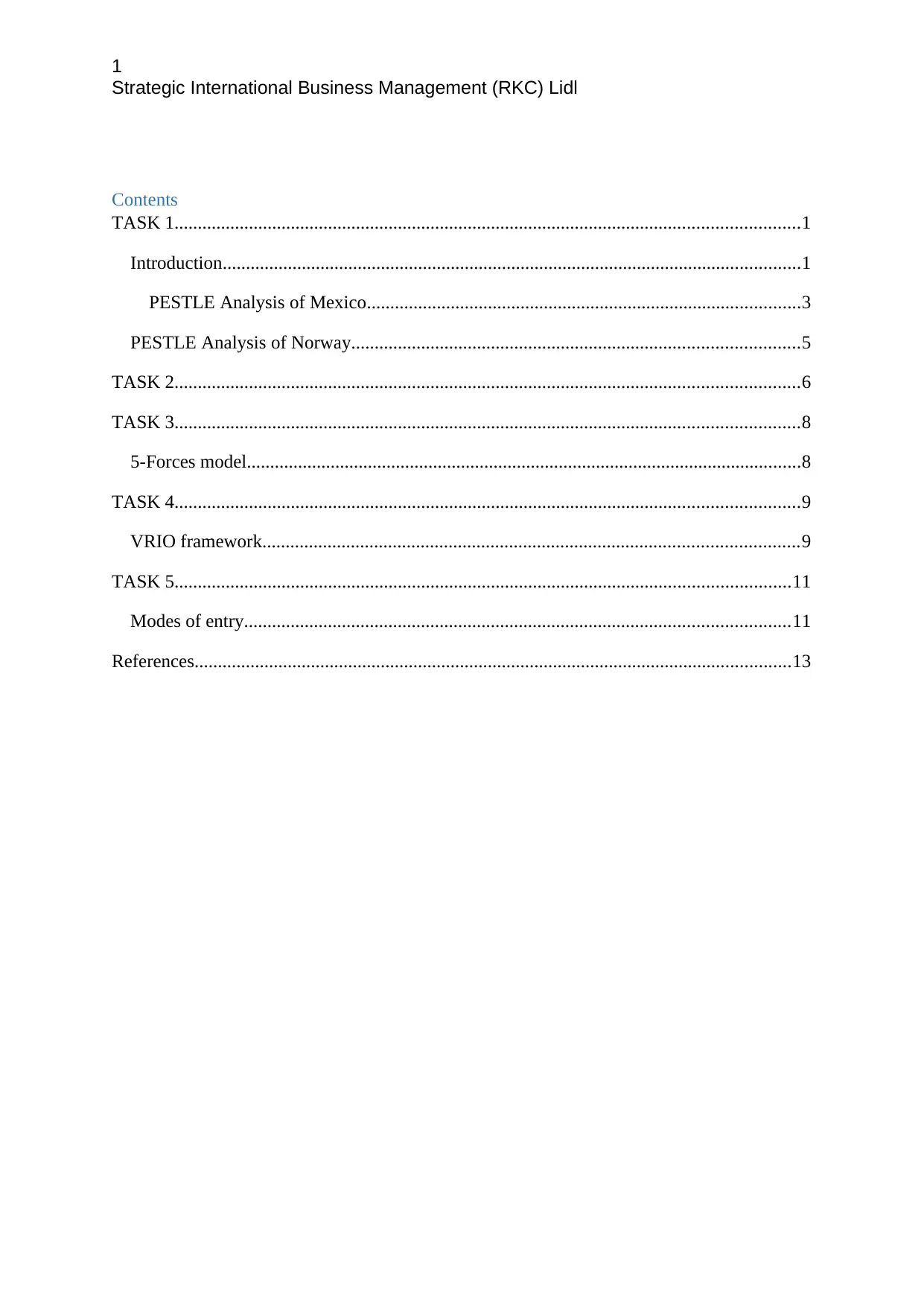
1
Strategic International Business Management (RKC) Lidl
Contents
TASK 1......................................................................................................................................1
Introduction............................................................................................................................1
PESTLE Analysis of Mexico.............................................................................................3
PESTLE Analysis of Norway................................................................................................5
TASK 2......................................................................................................................................6
TASK 3......................................................................................................................................8
5-Forces model.......................................................................................................................8
TASK 4......................................................................................................................................9
VRIO framework...................................................................................................................9
TASK 5....................................................................................................................................11
Modes of entry.....................................................................................................................11
References................................................................................................................................13
Strategic International Business Management (RKC) Lidl
Contents
TASK 1......................................................................................................................................1
Introduction............................................................................................................................1
PESTLE Analysis of Mexico.............................................................................................3
PESTLE Analysis of Norway................................................................................................5
TASK 2......................................................................................................................................6
TASK 3......................................................................................................................................8
5-Forces model.......................................................................................................................8
TASK 4......................................................................................................................................9
VRIO framework...................................................................................................................9
TASK 5....................................................................................................................................11
Modes of entry.....................................................................................................................11
References................................................................................................................................13
Paraphrase This Document
Need a fresh take? Get an instant paraphrase of this document with our AI Paraphraser
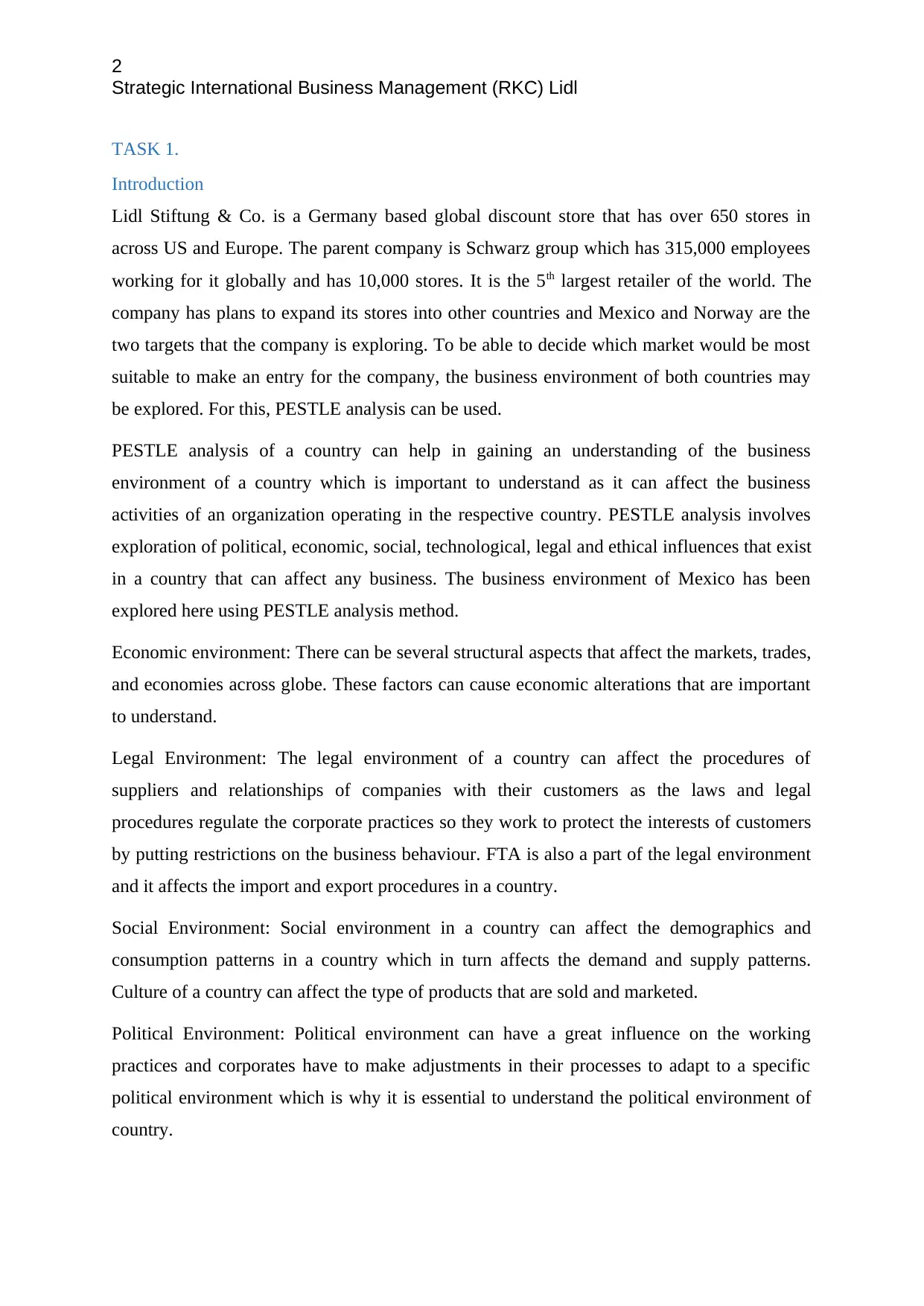
2
Strategic International Business Management (RKC) Lidl
TASK 1.
Introduction
Lidl Stiftung & Co. is a Germany based global discount store that has over 650 stores in
across US and Europe. The parent company is Schwarz group which has 315,000 employees
working for it globally and has 10,000 stores. It is the 5th largest retailer of the world. The
company has plans to expand its stores into other countries and Mexico and Norway are the
two targets that the company is exploring. To be able to decide which market would be most
suitable to make an entry for the company, the business environment of both countries may
be explored. For this, PESTLE analysis can be used.
PESTLE analysis of a country can help in gaining an understanding of the business
environment of a country which is important to understand as it can affect the business
activities of an organization operating in the respective country. PESTLE analysis involves
exploration of political, economic, social, technological, legal and ethical influences that exist
in a country that can affect any business. The business environment of Mexico has been
explored here using PESTLE analysis method.
Economic environment: There can be several structural aspects that affect the markets, trades,
and economies across globe. These factors can cause economic alterations that are important
to understand.
Legal Environment: The legal environment of a country can affect the procedures of
suppliers and relationships of companies with their customers as the laws and legal
procedures regulate the corporate practices so they work to protect the interests of customers
by putting restrictions on the business behaviour. FTA is also a part of the legal environment
and it affects the import and export procedures in a country.
Social Environment: Social environment in a country can affect the demographics and
consumption patterns in a country which in turn affects the demand and supply patterns.
Culture of a country can affect the type of products that are sold and marketed.
Political Environment: Political environment can have a great influence on the working
practices and corporates have to make adjustments in their processes to adapt to a specific
political environment which is why it is essential to understand the political environment of
country.
Strategic International Business Management (RKC) Lidl
TASK 1.
Introduction
Lidl Stiftung & Co. is a Germany based global discount store that has over 650 stores in
across US and Europe. The parent company is Schwarz group which has 315,000 employees
working for it globally and has 10,000 stores. It is the 5th largest retailer of the world. The
company has plans to expand its stores into other countries and Mexico and Norway are the
two targets that the company is exploring. To be able to decide which market would be most
suitable to make an entry for the company, the business environment of both countries may
be explored. For this, PESTLE analysis can be used.
PESTLE analysis of a country can help in gaining an understanding of the business
environment of a country which is important to understand as it can affect the business
activities of an organization operating in the respective country. PESTLE analysis involves
exploration of political, economic, social, technological, legal and ethical influences that exist
in a country that can affect any business. The business environment of Mexico has been
explored here using PESTLE analysis method.
Economic environment: There can be several structural aspects that affect the markets, trades,
and economies across globe. These factors can cause economic alterations that are important
to understand.
Legal Environment: The legal environment of a country can affect the procedures of
suppliers and relationships of companies with their customers as the laws and legal
procedures regulate the corporate practices so they work to protect the interests of customers
by putting restrictions on the business behaviour. FTA is also a part of the legal environment
and it affects the import and export procedures in a country.
Social Environment: Social environment in a country can affect the demographics and
consumption patterns in a country which in turn affects the demand and supply patterns.
Culture of a country can affect the type of products that are sold and marketed.
Political Environment: Political environment can have a great influence on the working
practices and corporates have to make adjustments in their processes to adapt to a specific
political environment which is why it is essential to understand the political environment of
country.
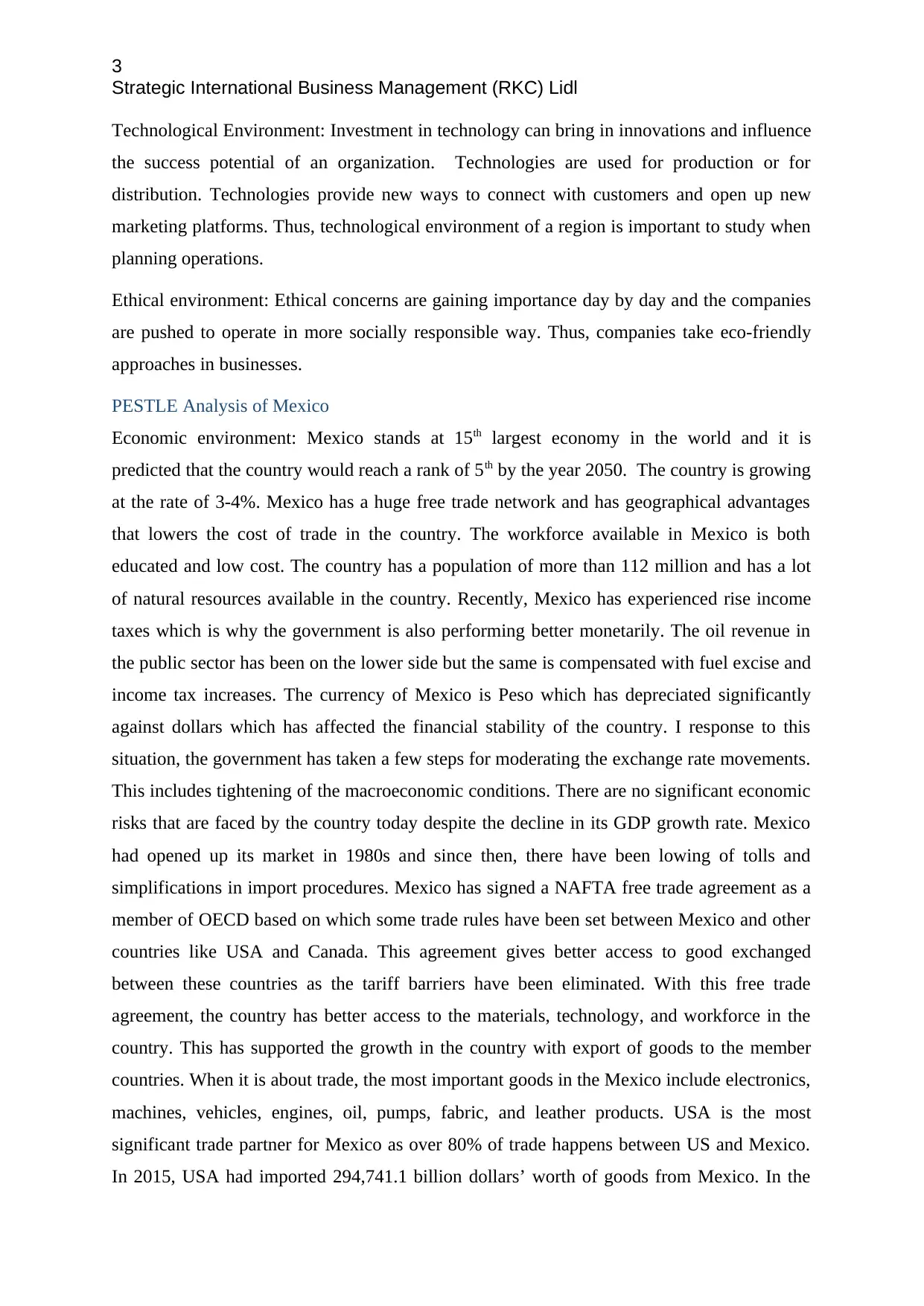
3
Strategic International Business Management (RKC) Lidl
Technological Environment: Investment in technology can bring in innovations and influence
the success potential of an organization. Technologies are used for production or for
distribution. Technologies provide new ways to connect with customers and open up new
marketing platforms. Thus, technological environment of a region is important to study when
planning operations.
Ethical environment: Ethical concerns are gaining importance day by day and the companies
are pushed to operate in more socially responsible way. Thus, companies take eco-friendly
approaches in businesses.
PESTLE Analysis of Mexico
Economic environment: Mexico stands at 15th largest economy in the world and it is
predicted that the country would reach a rank of 5th by the year 2050. The country is growing
at the rate of 3-4%. Mexico has a huge free trade network and has geographical advantages
that lowers the cost of trade in the country. The workforce available in Mexico is both
educated and low cost. The country has a population of more than 112 million and has a lot
of natural resources available in the country. Recently, Mexico has experienced rise income
taxes which is why the government is also performing better monetarily. The oil revenue in
the public sector has been on the lower side but the same is compensated with fuel excise and
income tax increases. The currency of Mexico is Peso which has depreciated significantly
against dollars which has affected the financial stability of the country. I response to this
situation, the government has taken a few steps for moderating the exchange rate movements.
This includes tightening of the macroeconomic conditions. There are no significant economic
risks that are faced by the country today despite the decline in its GDP growth rate. Mexico
had opened up its market in 1980s and since then, there have been lowing of tolls and
simplifications in import procedures. Mexico has signed a NAFTA free trade agreement as a
member of OECD based on which some trade rules have been set between Mexico and other
countries like USA and Canada. This agreement gives better access to good exchanged
between these countries as the tariff barriers have been eliminated. With this free trade
agreement, the country has better access to the materials, technology, and workforce in the
country. This has supported the growth in the country with export of goods to the member
countries. When it is about trade, the most important goods in the Mexico include electronics,
machines, vehicles, engines, oil, pumps, fabric, and leather products. USA is the most
significant trade partner for Mexico as over 80% of trade happens between US and Mexico.
In 2015, USA had imported 294,741.1 billion dollars’ worth of goods from Mexico. In the
Strategic International Business Management (RKC) Lidl
Technological Environment: Investment in technology can bring in innovations and influence
the success potential of an organization. Technologies are used for production or for
distribution. Technologies provide new ways to connect with customers and open up new
marketing platforms. Thus, technological environment of a region is important to study when
planning operations.
Ethical environment: Ethical concerns are gaining importance day by day and the companies
are pushed to operate in more socially responsible way. Thus, companies take eco-friendly
approaches in businesses.
PESTLE Analysis of Mexico
Economic environment: Mexico stands at 15th largest economy in the world and it is
predicted that the country would reach a rank of 5th by the year 2050. The country is growing
at the rate of 3-4%. Mexico has a huge free trade network and has geographical advantages
that lowers the cost of trade in the country. The workforce available in Mexico is both
educated and low cost. The country has a population of more than 112 million and has a lot
of natural resources available in the country. Recently, Mexico has experienced rise income
taxes which is why the government is also performing better monetarily. The oil revenue in
the public sector has been on the lower side but the same is compensated with fuel excise and
income tax increases. The currency of Mexico is Peso which has depreciated significantly
against dollars which has affected the financial stability of the country. I response to this
situation, the government has taken a few steps for moderating the exchange rate movements.
This includes tightening of the macroeconomic conditions. There are no significant economic
risks that are faced by the country today despite the decline in its GDP growth rate. Mexico
had opened up its market in 1980s and since then, there have been lowing of tolls and
simplifications in import procedures. Mexico has signed a NAFTA free trade agreement as a
member of OECD based on which some trade rules have been set between Mexico and other
countries like USA and Canada. This agreement gives better access to good exchanged
between these countries as the tariff barriers have been eliminated. With this free trade
agreement, the country has better access to the materials, technology, and workforce in the
country. This has supported the growth in the country with export of goods to the member
countries. When it is about trade, the most important goods in the Mexico include electronics,
machines, vehicles, engines, oil, pumps, fabric, and leather products. USA is the most
significant trade partner for Mexico as over 80% of trade happens between US and Mexico.
In 2015, USA had imported 294,741.1 billion dollars’ worth of goods from Mexico. In the
⊘ This is a preview!⊘
Do you want full access?
Subscribe today to unlock all pages.

Trusted by 1+ million students worldwide
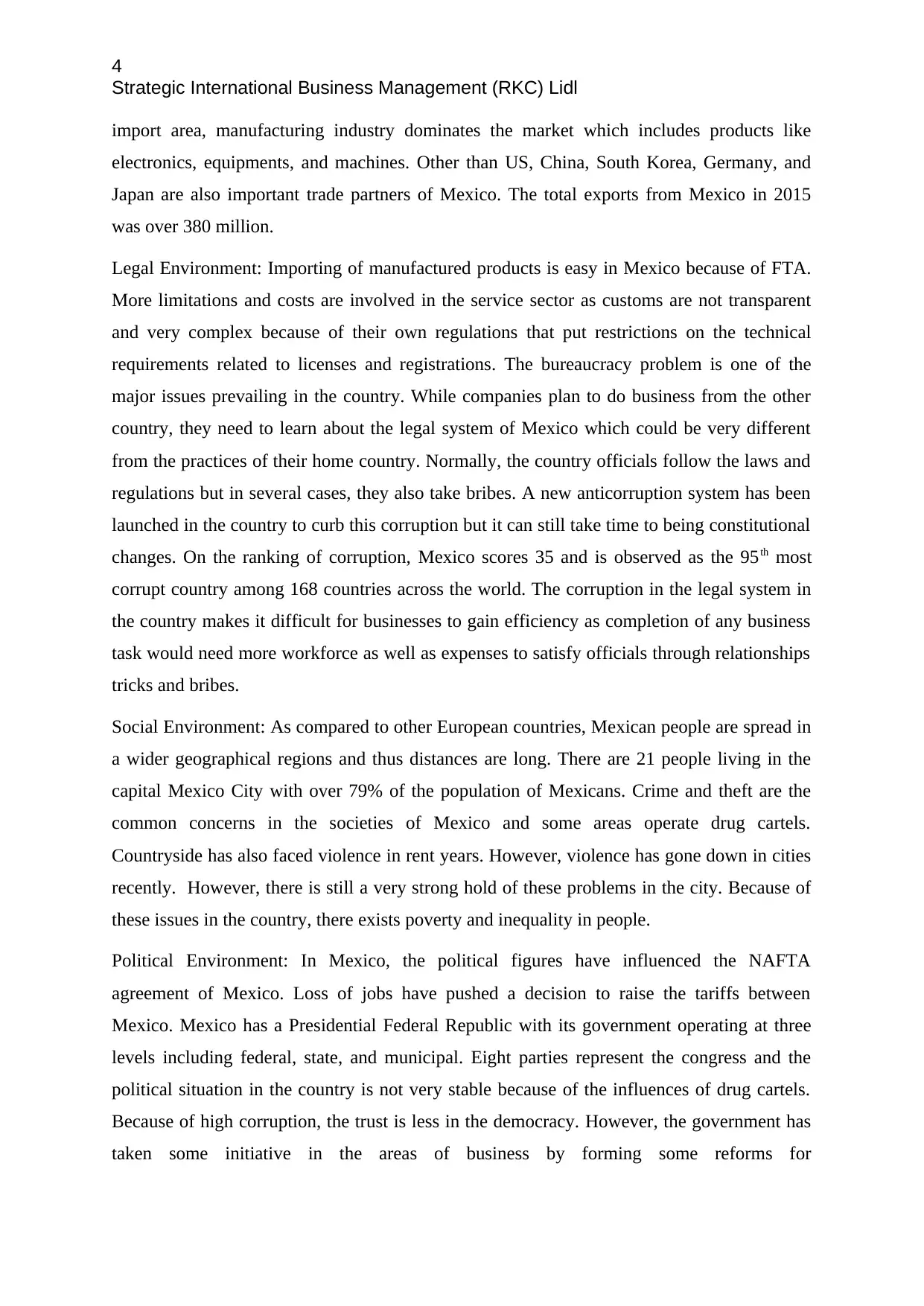
4
Strategic International Business Management (RKC) Lidl
import area, manufacturing industry dominates the market which includes products like
electronics, equipments, and machines. Other than US, China, South Korea, Germany, and
Japan are also important trade partners of Mexico. The total exports from Mexico in 2015
was over 380 million.
Legal Environment: Importing of manufactured products is easy in Mexico because of FTA.
More limitations and costs are involved in the service sector as customs are not transparent
and very complex because of their own regulations that put restrictions on the technical
requirements related to licenses and registrations. The bureaucracy problem is one of the
major issues prevailing in the country. While companies plan to do business from the other
country, they need to learn about the legal system of Mexico which could be very different
from the practices of their home country. Normally, the country officials follow the laws and
regulations but in several cases, they also take bribes. A new anticorruption system has been
launched in the country to curb this corruption but it can still take time to being constitutional
changes. On the ranking of corruption, Mexico scores 35 and is observed as the 95th most
corrupt country among 168 countries across the world. The corruption in the legal system in
the country makes it difficult for businesses to gain efficiency as completion of any business
task would need more workforce as well as expenses to satisfy officials through relationships
tricks and bribes.
Social Environment: As compared to other European countries, Mexican people are spread in
a wider geographical regions and thus distances are long. There are 21 people living in the
capital Mexico City with over 79% of the population of Mexicans. Crime and theft are the
common concerns in the societies of Mexico and some areas operate drug cartels.
Countryside has also faced violence in rent years. However, violence has gone down in cities
recently. However, there is still a very strong hold of these problems in the city. Because of
these issues in the country, there exists poverty and inequality in people.
Political Environment: In Mexico, the political figures have influenced the NAFTA
agreement of Mexico. Loss of jobs have pushed a decision to raise the tariffs between
Mexico. Mexico has a Presidential Federal Republic with its government operating at three
levels including federal, state, and municipal. Eight parties represent the congress and the
political situation in the country is not very stable because of the influences of drug cartels.
Because of high corruption, the trust is less in the democracy. However, the government has
taken some initiative in the areas of business by forming some reforms for
Strategic International Business Management (RKC) Lidl
import area, manufacturing industry dominates the market which includes products like
electronics, equipments, and machines. Other than US, China, South Korea, Germany, and
Japan are also important trade partners of Mexico. The total exports from Mexico in 2015
was over 380 million.
Legal Environment: Importing of manufactured products is easy in Mexico because of FTA.
More limitations and costs are involved in the service sector as customs are not transparent
and very complex because of their own regulations that put restrictions on the technical
requirements related to licenses and registrations. The bureaucracy problem is one of the
major issues prevailing in the country. While companies plan to do business from the other
country, they need to learn about the legal system of Mexico which could be very different
from the practices of their home country. Normally, the country officials follow the laws and
regulations but in several cases, they also take bribes. A new anticorruption system has been
launched in the country to curb this corruption but it can still take time to being constitutional
changes. On the ranking of corruption, Mexico scores 35 and is observed as the 95th most
corrupt country among 168 countries across the world. The corruption in the legal system in
the country makes it difficult for businesses to gain efficiency as completion of any business
task would need more workforce as well as expenses to satisfy officials through relationships
tricks and bribes.
Social Environment: As compared to other European countries, Mexican people are spread in
a wider geographical regions and thus distances are long. There are 21 people living in the
capital Mexico City with over 79% of the population of Mexicans. Crime and theft are the
common concerns in the societies of Mexico and some areas operate drug cartels.
Countryside has also faced violence in rent years. However, violence has gone down in cities
recently. However, there is still a very strong hold of these problems in the city. Because of
these issues in the country, there exists poverty and inequality in people.
Political Environment: In Mexico, the political figures have influenced the NAFTA
agreement of Mexico. Loss of jobs have pushed a decision to raise the tariffs between
Mexico. Mexico has a Presidential Federal Republic with its government operating at three
levels including federal, state, and municipal. Eight parties represent the congress and the
political situation in the country is not very stable because of the influences of drug cartels.
Because of high corruption, the trust is less in the democracy. However, the government has
taken some initiative in the areas of business by forming some reforms for
Paraphrase This Document
Need a fresh take? Get an instant paraphrase of this document with our AI Paraphraser
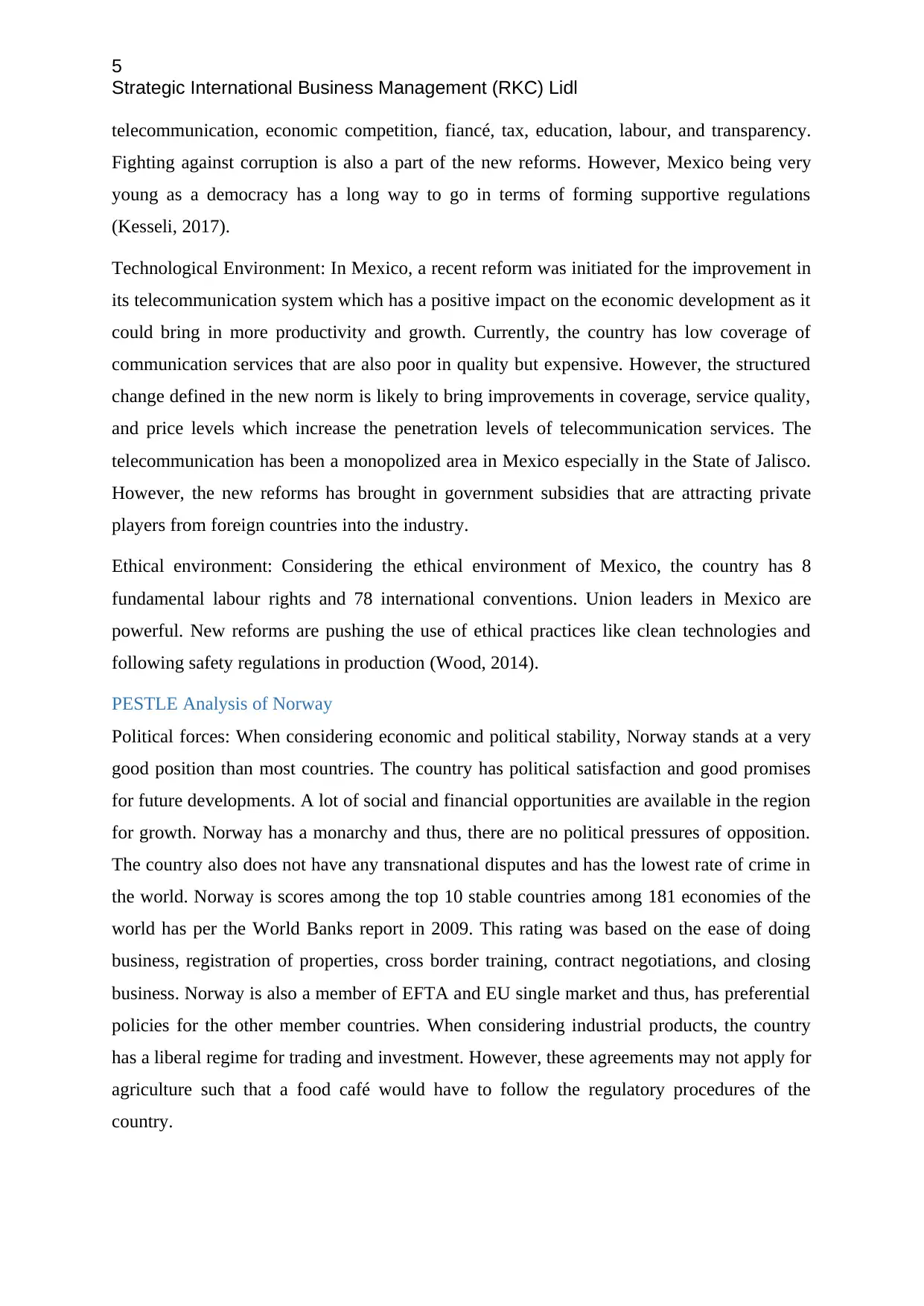
5
Strategic International Business Management (RKC) Lidl
telecommunication, economic competition, fiancé, tax, education, labour, and transparency.
Fighting against corruption is also a part of the new reforms. However, Mexico being very
young as a democracy has a long way to go in terms of forming supportive regulations
(Kesseli, 2017).
Technological Environment: In Mexico, a recent reform was initiated for the improvement in
its telecommunication system which has a positive impact on the economic development as it
could bring in more productivity and growth. Currently, the country has low coverage of
communication services that are also poor in quality but expensive. However, the structured
change defined in the new norm is likely to bring improvements in coverage, service quality,
and price levels which increase the penetration levels of telecommunication services. The
telecommunication has been a monopolized area in Mexico especially in the State of Jalisco.
However, the new reforms has brought in government subsidies that are attracting private
players from foreign countries into the industry.
Ethical environment: Considering the ethical environment of Mexico, the country has 8
fundamental labour rights and 78 international conventions. Union leaders in Mexico are
powerful. New reforms are pushing the use of ethical practices like clean technologies and
following safety regulations in production (Wood, 2014).
PESTLE Analysis of Norway
Political forces: When considering economic and political stability, Norway stands at a very
good position than most countries. The country has political satisfaction and good promises
for future developments. A lot of social and financial opportunities are available in the region
for growth. Norway has a monarchy and thus, there are no political pressures of opposition.
The country also does not have any transnational disputes and has the lowest rate of crime in
the world. Norway is scores among the top 10 stable countries among 181 economies of the
world has per the World Banks report in 2009. This rating was based on the ease of doing
business, registration of properties, cross border training, contract negotiations, and closing
business. Norway is also a member of EFTA and EU single market and thus, has preferential
policies for the other member countries. When considering industrial products, the country
has a liberal regime for trading and investment. However, these agreements may not apply for
agriculture such that a food café would have to follow the regulatory procedures of the
country.
Strategic International Business Management (RKC) Lidl
telecommunication, economic competition, fiancé, tax, education, labour, and transparency.
Fighting against corruption is also a part of the new reforms. However, Mexico being very
young as a democracy has a long way to go in terms of forming supportive regulations
(Kesseli, 2017).
Technological Environment: In Mexico, a recent reform was initiated for the improvement in
its telecommunication system which has a positive impact on the economic development as it
could bring in more productivity and growth. Currently, the country has low coverage of
communication services that are also poor in quality but expensive. However, the structured
change defined in the new norm is likely to bring improvements in coverage, service quality,
and price levels which increase the penetration levels of telecommunication services. The
telecommunication has been a monopolized area in Mexico especially in the State of Jalisco.
However, the new reforms has brought in government subsidies that are attracting private
players from foreign countries into the industry.
Ethical environment: Considering the ethical environment of Mexico, the country has 8
fundamental labour rights and 78 international conventions. Union leaders in Mexico are
powerful. New reforms are pushing the use of ethical practices like clean technologies and
following safety regulations in production (Wood, 2014).
PESTLE Analysis of Norway
Political forces: When considering economic and political stability, Norway stands at a very
good position than most countries. The country has political satisfaction and good promises
for future developments. A lot of social and financial opportunities are available in the region
for growth. Norway has a monarchy and thus, there are no political pressures of opposition.
The country also does not have any transnational disputes and has the lowest rate of crime in
the world. Norway is scores among the top 10 stable countries among 181 economies of the
world has per the World Banks report in 2009. This rating was based on the ease of doing
business, registration of properties, cross border training, contract negotiations, and closing
business. Norway is also a member of EFTA and EU single market and thus, has preferential
policies for the other member countries. When considering industrial products, the country
has a liberal regime for trading and investment. However, these agreements may not apply for
agriculture such that a food café would have to follow the regulatory procedures of the
country.
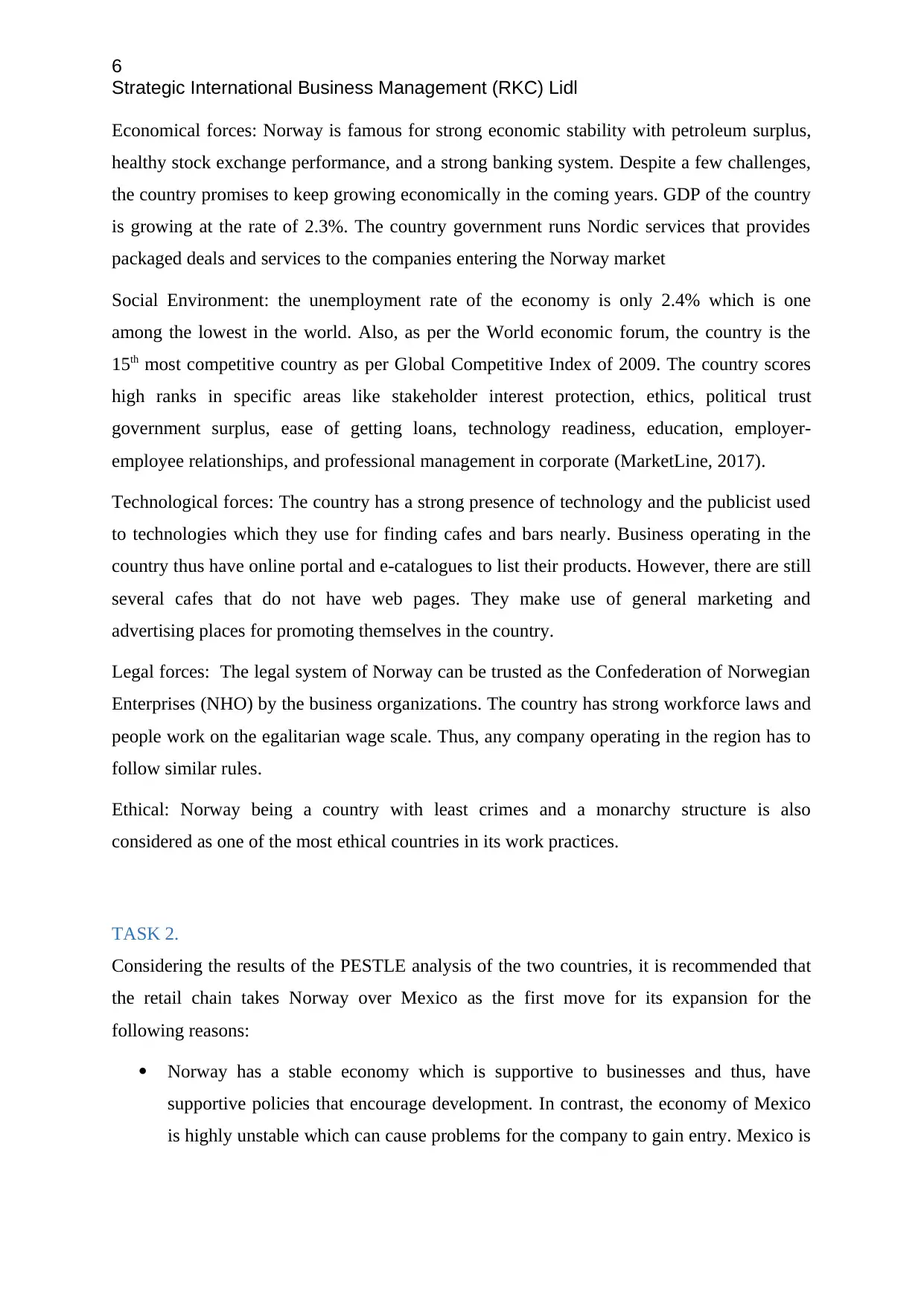
6
Strategic International Business Management (RKC) Lidl
Economical forces: Norway is famous for strong economic stability with petroleum surplus,
healthy stock exchange performance, and a strong banking system. Despite a few challenges,
the country promises to keep growing economically in the coming years. GDP of the country
is growing at the rate of 2.3%. The country government runs Nordic services that provides
packaged deals and services to the companies entering the Norway market
Social Environment: the unemployment rate of the economy is only 2.4% which is one
among the lowest in the world. Also, as per the World economic forum, the country is the
15th most competitive country as per Global Competitive Index of 2009. The country scores
high ranks in specific areas like stakeholder interest protection, ethics, political trust
government surplus, ease of getting loans, technology readiness, education, employer-
employee relationships, and professional management in corporate (MarketLine, 2017).
Technological forces: The country has a strong presence of technology and the publicist used
to technologies which they use for finding cafes and bars nearly. Business operating in the
country thus have online portal and e-catalogues to list their products. However, there are still
several cafes that do not have web pages. They make use of general marketing and
advertising places for promoting themselves in the country.
Legal forces: The legal system of Norway can be trusted as the Confederation of Norwegian
Enterprises (NHO) by the business organizations. The country has strong workforce laws and
people work on the egalitarian wage scale. Thus, any company operating in the region has to
follow similar rules.
Ethical: Norway being a country with least crimes and a monarchy structure is also
considered as one of the most ethical countries in its work practices.
TASK 2.
Considering the results of the PESTLE analysis of the two countries, it is recommended that
the retail chain takes Norway over Mexico as the first move for its expansion for the
following reasons:
Norway has a stable economy which is supportive to businesses and thus, have
supportive policies that encourage development. In contrast, the economy of Mexico
is highly unstable which can cause problems for the company to gain entry. Mexico is
Strategic International Business Management (RKC) Lidl
Economical forces: Norway is famous for strong economic stability with petroleum surplus,
healthy stock exchange performance, and a strong banking system. Despite a few challenges,
the country promises to keep growing economically in the coming years. GDP of the country
is growing at the rate of 2.3%. The country government runs Nordic services that provides
packaged deals and services to the companies entering the Norway market
Social Environment: the unemployment rate of the economy is only 2.4% which is one
among the lowest in the world. Also, as per the World economic forum, the country is the
15th most competitive country as per Global Competitive Index of 2009. The country scores
high ranks in specific areas like stakeholder interest protection, ethics, political trust
government surplus, ease of getting loans, technology readiness, education, employer-
employee relationships, and professional management in corporate (MarketLine, 2017).
Technological forces: The country has a strong presence of technology and the publicist used
to technologies which they use for finding cafes and bars nearly. Business operating in the
country thus have online portal and e-catalogues to list their products. However, there are still
several cafes that do not have web pages. They make use of general marketing and
advertising places for promoting themselves in the country.
Legal forces: The legal system of Norway can be trusted as the Confederation of Norwegian
Enterprises (NHO) by the business organizations. The country has strong workforce laws and
people work on the egalitarian wage scale. Thus, any company operating in the region has to
follow similar rules.
Ethical: Norway being a country with least crimes and a monarchy structure is also
considered as one of the most ethical countries in its work practices.
TASK 2.
Considering the results of the PESTLE analysis of the two countries, it is recommended that
the retail chain takes Norway over Mexico as the first move for its expansion for the
following reasons:
Norway has a stable economy which is supportive to businesses and thus, have
supportive policies that encourage development. In contrast, the economy of Mexico
is highly unstable which can cause problems for the company to gain entry. Mexico is
⊘ This is a preview!⊘
Do you want full access?
Subscribe today to unlock all pages.

Trusted by 1+ million students worldwide
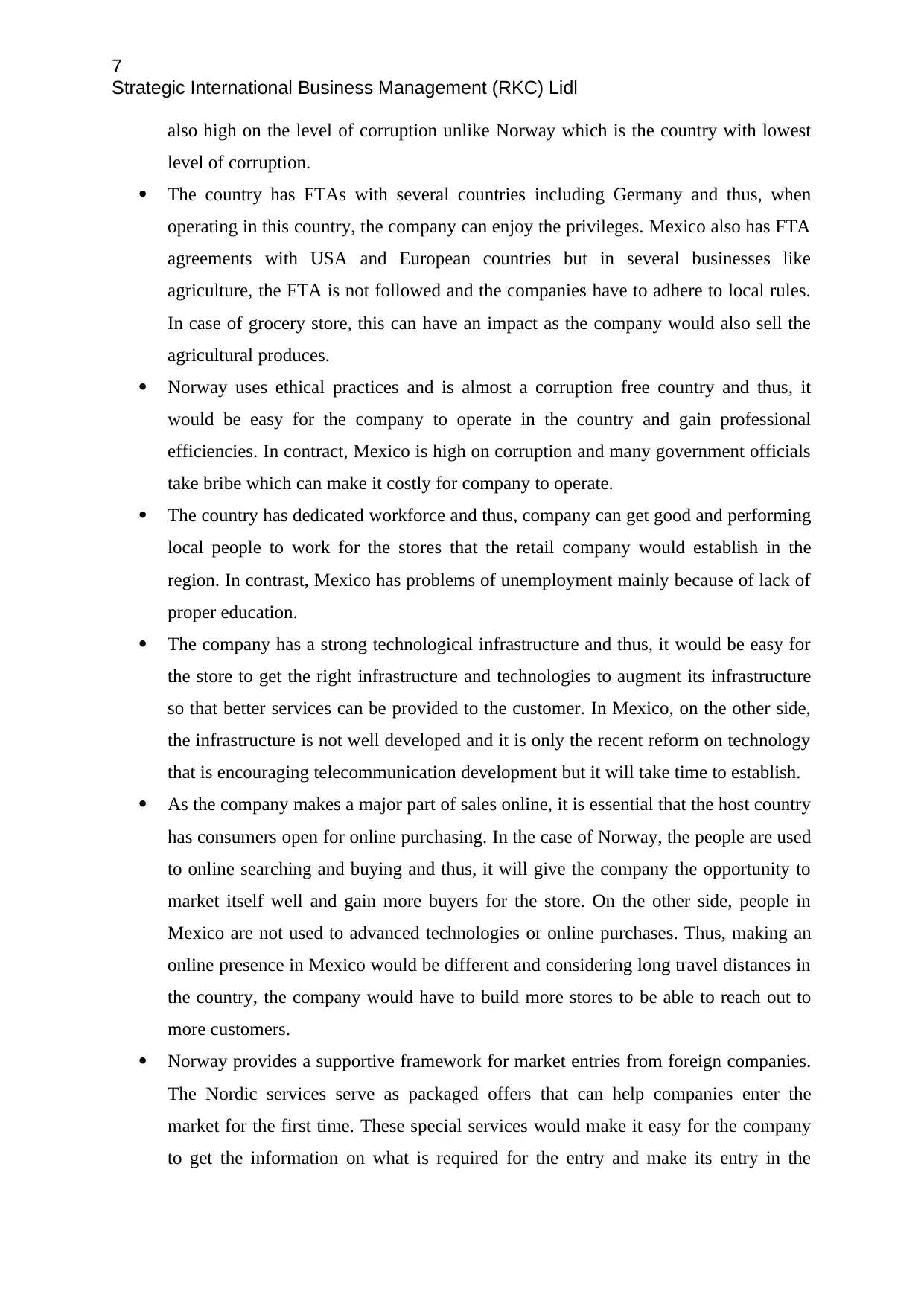
7
Strategic International Business Management (RKC) Lidl
also high on the level of corruption unlike Norway which is the country with lowest
level of corruption.
The country has FTAs with several countries including Germany and thus, when
operating in this country, the company can enjoy the privileges. Mexico also has FTA
agreements with USA and European countries but in several businesses like
agriculture, the FTA is not followed and the companies have to adhere to local rules.
In case of grocery store, this can have an impact as the company would also sell the
agricultural produces.
Norway uses ethical practices and is almost a corruption free country and thus, it
would be easy for the company to operate in the country and gain professional
efficiencies. In contract, Mexico is high on corruption and many government officials
take bribe which can make it costly for company to operate.
The country has dedicated workforce and thus, company can get good and performing
local people to work for the stores that the retail company would establish in the
region. In contrast, Mexico has problems of unemployment mainly because of lack of
proper education.
The company has a strong technological infrastructure and thus, it would be easy for
the store to get the right infrastructure and technologies to augment its infrastructure
so that better services can be provided to the customer. In Mexico, on the other side,
the infrastructure is not well developed and it is only the recent reform on technology
that is encouraging telecommunication development but it will take time to establish.
As the company makes a major part of sales online, it is essential that the host country
has consumers open for online purchasing. In the case of Norway, the people are used
to online searching and buying and thus, it will give the company the opportunity to
market itself well and gain more buyers for the store. On the other side, people in
Mexico are not used to advanced technologies or online purchases. Thus, making an
online presence in Mexico would be different and considering long travel distances in
the country, the company would have to build more stores to be able to reach out to
more customers.
Norway provides a supportive framework for market entries from foreign companies.
The Nordic services serve as packaged offers that can help companies enter the
market for the first time. These special services would make it easy for the company
to get the information on what is required for the entry and make its entry in the
Strategic International Business Management (RKC) Lidl
also high on the level of corruption unlike Norway which is the country with lowest
level of corruption.
The country has FTAs with several countries including Germany and thus, when
operating in this country, the company can enjoy the privileges. Mexico also has FTA
agreements with USA and European countries but in several businesses like
agriculture, the FTA is not followed and the companies have to adhere to local rules.
In case of grocery store, this can have an impact as the company would also sell the
agricultural produces.
Norway uses ethical practices and is almost a corruption free country and thus, it
would be easy for the company to operate in the country and gain professional
efficiencies. In contract, Mexico is high on corruption and many government officials
take bribe which can make it costly for company to operate.
The country has dedicated workforce and thus, company can get good and performing
local people to work for the stores that the retail company would establish in the
region. In contrast, Mexico has problems of unemployment mainly because of lack of
proper education.
The company has a strong technological infrastructure and thus, it would be easy for
the store to get the right infrastructure and technologies to augment its infrastructure
so that better services can be provided to the customer. In Mexico, on the other side,
the infrastructure is not well developed and it is only the recent reform on technology
that is encouraging telecommunication development but it will take time to establish.
As the company makes a major part of sales online, it is essential that the host country
has consumers open for online purchasing. In the case of Norway, the people are used
to online searching and buying and thus, it will give the company the opportunity to
market itself well and gain more buyers for the store. On the other side, people in
Mexico are not used to advanced technologies or online purchases. Thus, making an
online presence in Mexico would be different and considering long travel distances in
the country, the company would have to build more stores to be able to reach out to
more customers.
Norway provides a supportive framework for market entries from foreign companies.
The Nordic services serve as packaged offers that can help companies enter the
market for the first time. These special services would make it easy for the company
to get the information on what is required for the entry and make its entry in the
Paraphrase This Document
Need a fresh take? Get an instant paraphrase of this document with our AI Paraphraser
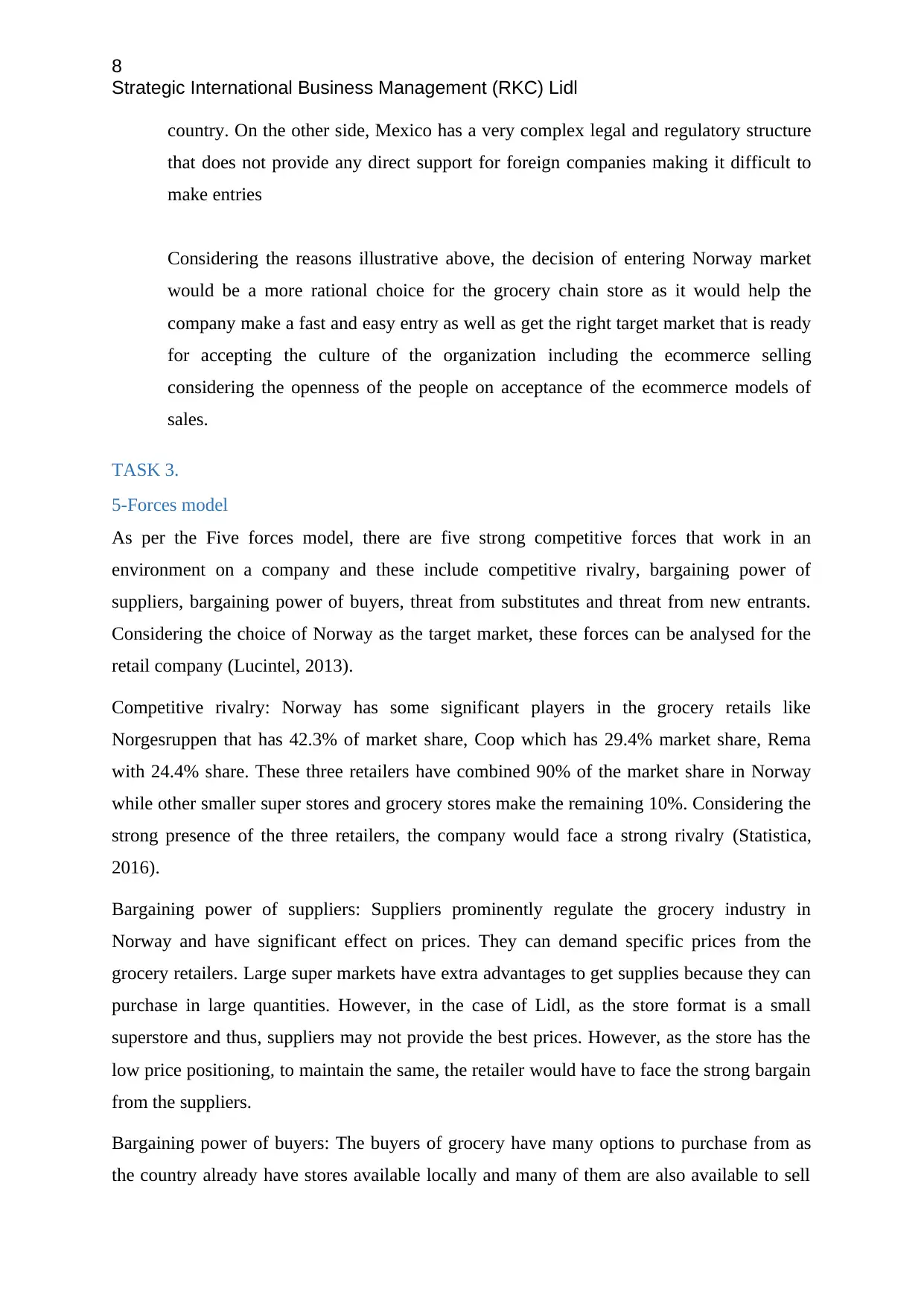
8
Strategic International Business Management (RKC) Lidl
country. On the other side, Mexico has a very complex legal and regulatory structure
that does not provide any direct support for foreign companies making it difficult to
make entries
Considering the reasons illustrative above, the decision of entering Norway market
would be a more rational choice for the grocery chain store as it would help the
company make a fast and easy entry as well as get the right target market that is ready
for accepting the culture of the organization including the ecommerce selling
considering the openness of the people on acceptance of the ecommerce models of
sales.
TASK 3.
5-Forces model
As per the Five forces model, there are five strong competitive forces that work in an
environment on a company and these include competitive rivalry, bargaining power of
suppliers, bargaining power of buyers, threat from substitutes and threat from new entrants.
Considering the choice of Norway as the target market, these forces can be analysed for the
retail company (Lucintel, 2013).
Competitive rivalry: Norway has some significant players in the grocery retails like
Norgesruppen that has 42.3% of market share, Coop which has 29.4% market share, Rema
with 24.4% share. These three retailers have combined 90% of the market share in Norway
while other smaller super stores and grocery stores make the remaining 10%. Considering the
strong presence of the three retailers, the company would face a strong rivalry (Statistica,
2016).
Bargaining power of suppliers: Suppliers prominently regulate the grocery industry in
Norway and have significant effect on prices. They can demand specific prices from the
grocery retailers. Large super markets have extra advantages to get supplies because they can
purchase in large quantities. However, in the case of Lidl, as the store format is a small
superstore and thus, suppliers may not provide the best prices. However, as the store has the
low price positioning, to maintain the same, the retailer would have to face the strong bargain
from the suppliers.
Bargaining power of buyers: The buyers of grocery have many options to purchase from as
the country already have stores available locally and many of them are also available to sell
Strategic International Business Management (RKC) Lidl
country. On the other side, Mexico has a very complex legal and regulatory structure
that does not provide any direct support for foreign companies making it difficult to
make entries
Considering the reasons illustrative above, the decision of entering Norway market
would be a more rational choice for the grocery chain store as it would help the
company make a fast and easy entry as well as get the right target market that is ready
for accepting the culture of the organization including the ecommerce selling
considering the openness of the people on acceptance of the ecommerce models of
sales.
TASK 3.
5-Forces model
As per the Five forces model, there are five strong competitive forces that work in an
environment on a company and these include competitive rivalry, bargaining power of
suppliers, bargaining power of buyers, threat from substitutes and threat from new entrants.
Considering the choice of Norway as the target market, these forces can be analysed for the
retail company (Lucintel, 2013).
Competitive rivalry: Norway has some significant players in the grocery retails like
Norgesruppen that has 42.3% of market share, Coop which has 29.4% market share, Rema
with 24.4% share. These three retailers have combined 90% of the market share in Norway
while other smaller super stores and grocery stores make the remaining 10%. Considering the
strong presence of the three retailers, the company would face a strong rivalry (Statistica,
2016).
Bargaining power of suppliers: Suppliers prominently regulate the grocery industry in
Norway and have significant effect on prices. They can demand specific prices from the
grocery retailers. Large super markets have extra advantages to get supplies because they can
purchase in large quantities. However, in the case of Lidl, as the store format is a small
superstore and thus, suppliers may not provide the best prices. However, as the store has the
low price positioning, to maintain the same, the retailer would have to face the strong bargain
from the suppliers.
Bargaining power of buyers: The buyers of grocery have many options to purchase from as
the country already have stores available locally and many of them are also available to sell
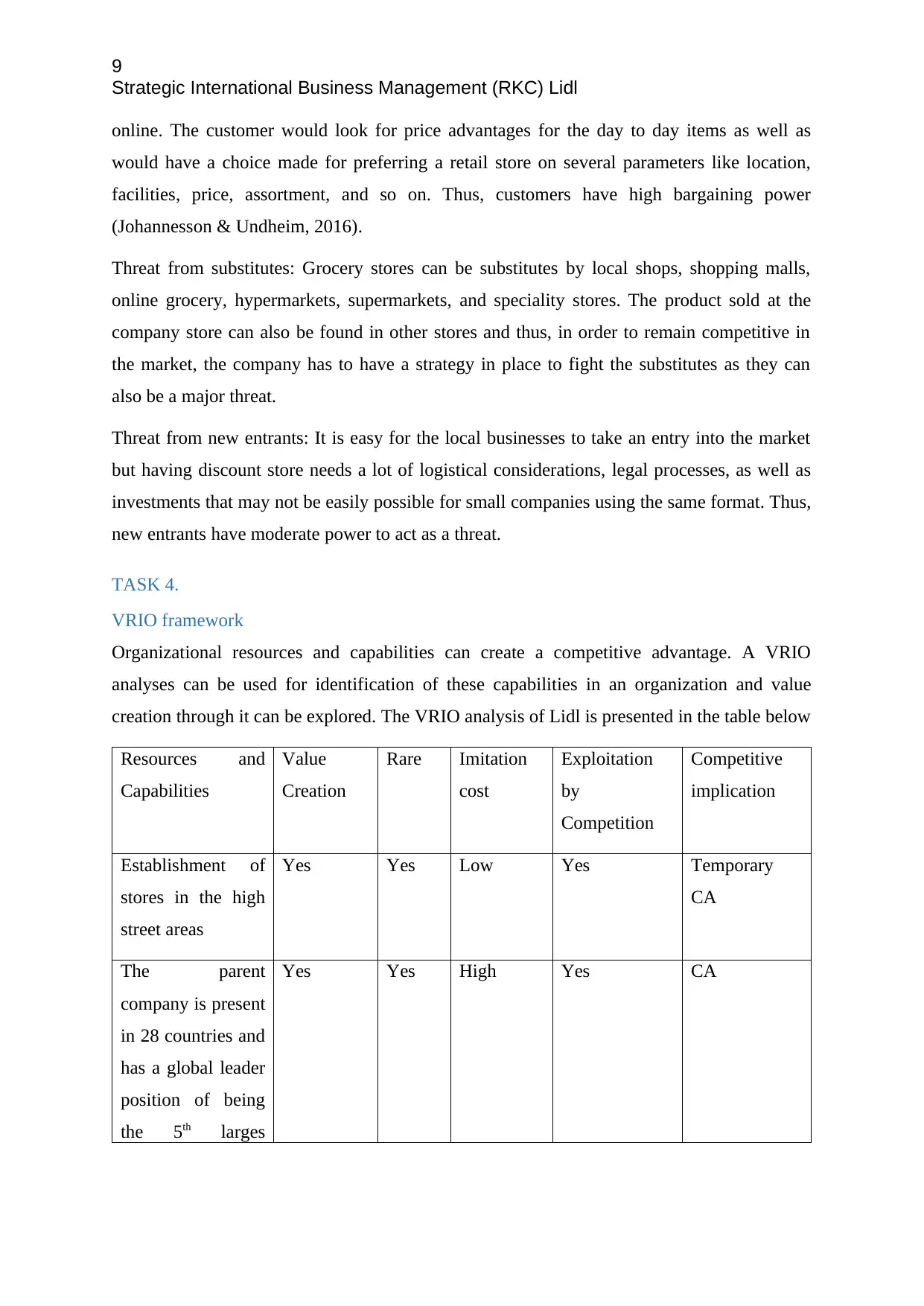
9
Strategic International Business Management (RKC) Lidl
online. The customer would look for price advantages for the day to day items as well as
would have a choice made for preferring a retail store on several parameters like location,
facilities, price, assortment, and so on. Thus, customers have high bargaining power
(Johannesson & Undheim, 2016).
Threat from substitutes: Grocery stores can be substitutes by local shops, shopping malls,
online grocery, hypermarkets, supermarkets, and speciality stores. The product sold at the
company store can also be found in other stores and thus, in order to remain competitive in
the market, the company has to have a strategy in place to fight the substitutes as they can
also be a major threat.
Threat from new entrants: It is easy for the local businesses to take an entry into the market
but having discount store needs a lot of logistical considerations, legal processes, as well as
investments that may not be easily possible for small companies using the same format. Thus,
new entrants have moderate power to act as a threat.
TASK 4.
VRIO framework
Organizational resources and capabilities can create a competitive advantage. A VRIO
analyses can be used for identification of these capabilities in an organization and value
creation through it can be explored. The VRIO analysis of Lidl is presented in the table below
Resources and
Capabilities
Value
Creation
Rare Imitation
cost
Exploitation
by
Competition
Competitive
implication
Establishment of
stores in the high
street areas
Yes Yes Low Yes Temporary
CA
The parent
company is present
in 28 countries and
has a global leader
position of being
the 5th larges
Yes Yes High Yes CA
Strategic International Business Management (RKC) Lidl
online. The customer would look for price advantages for the day to day items as well as
would have a choice made for preferring a retail store on several parameters like location,
facilities, price, assortment, and so on. Thus, customers have high bargaining power
(Johannesson & Undheim, 2016).
Threat from substitutes: Grocery stores can be substitutes by local shops, shopping malls,
online grocery, hypermarkets, supermarkets, and speciality stores. The product sold at the
company store can also be found in other stores and thus, in order to remain competitive in
the market, the company has to have a strategy in place to fight the substitutes as they can
also be a major threat.
Threat from new entrants: It is easy for the local businesses to take an entry into the market
but having discount store needs a lot of logistical considerations, legal processes, as well as
investments that may not be easily possible for small companies using the same format. Thus,
new entrants have moderate power to act as a threat.
TASK 4.
VRIO framework
Organizational resources and capabilities can create a competitive advantage. A VRIO
analyses can be used for identification of these capabilities in an organization and value
creation through it can be explored. The VRIO analysis of Lidl is presented in the table below
Resources and
Capabilities
Value
Creation
Rare Imitation
cost
Exploitation
by
Competition
Competitive
implication
Establishment of
stores in the high
street areas
Yes Yes Low Yes Temporary
CA
The parent
company is present
in 28 countries and
has a global leader
position of being
the 5th larges
Yes Yes High Yes CA
⊘ This is a preview!⊘
Do you want full access?
Subscribe today to unlock all pages.

Trusted by 1+ million students worldwide
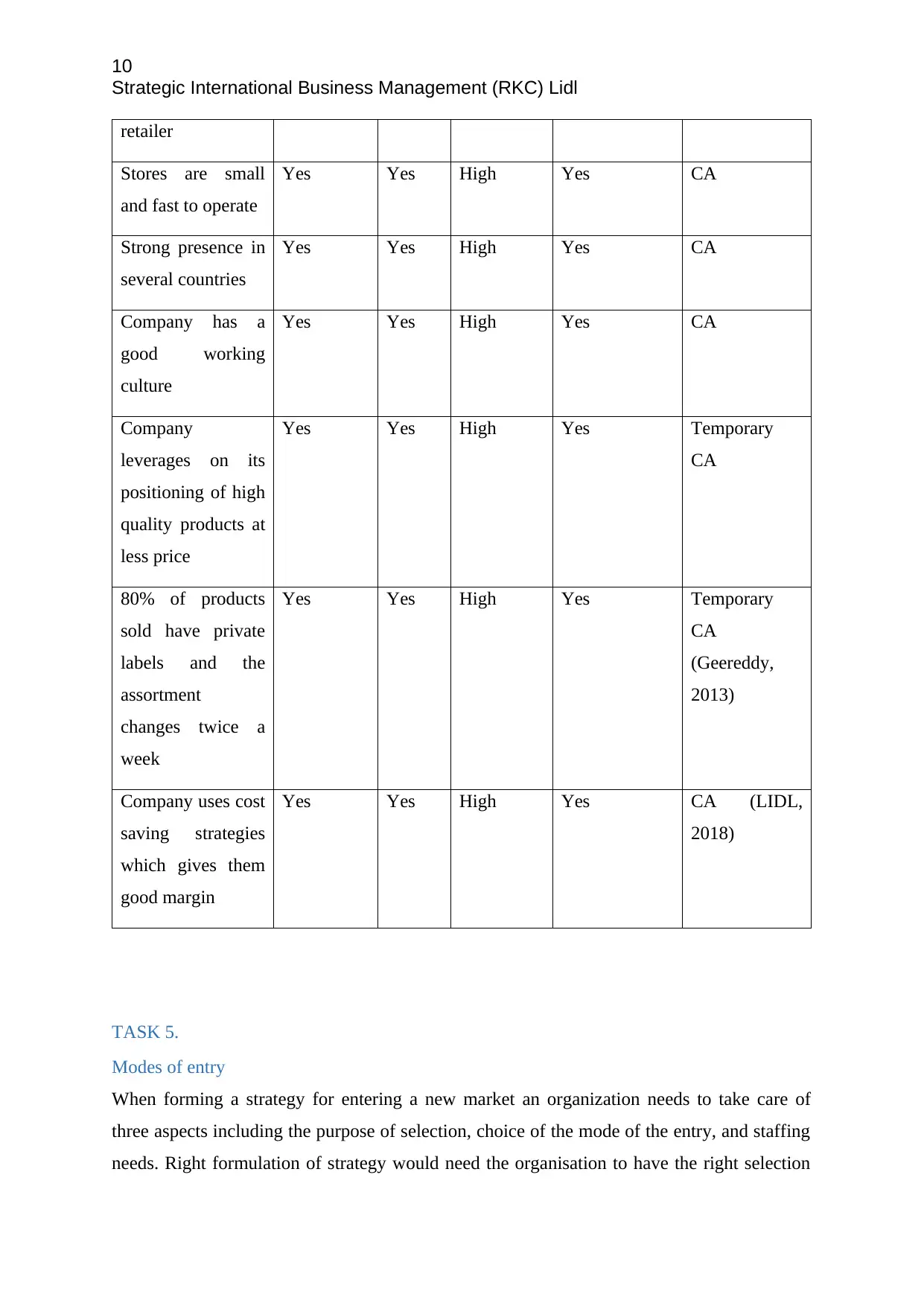
10
Strategic International Business Management (RKC) Lidl
retailer
Stores are small
and fast to operate
Yes Yes High Yes CA
Strong presence in
several countries
Yes Yes High Yes CA
Company has a
good working
culture
Yes Yes High Yes CA
Company
leverages on its
positioning of high
quality products at
less price
Yes Yes High Yes Temporary
CA
80% of products
sold have private
labels and the
assortment
changes twice a
week
Yes Yes High Yes Temporary
CA
(Geereddy,
2013)
Company uses cost
saving strategies
which gives them
good margin
Yes Yes High Yes CA (LIDL,
2018)
TASK 5.
Modes of entry
When forming a strategy for entering a new market an organization needs to take care of
three aspects including the purpose of selection, choice of the mode of the entry, and staffing
needs. Right formulation of strategy would need the organisation to have the right selection
Strategic International Business Management (RKC) Lidl
retailer
Stores are small
and fast to operate
Yes Yes High Yes CA
Strong presence in
several countries
Yes Yes High Yes CA
Company has a
good working
culture
Yes Yes High Yes CA
Company
leverages on its
positioning of high
quality products at
less price
Yes Yes High Yes Temporary
CA
80% of products
sold have private
labels and the
assortment
changes twice a
week
Yes Yes High Yes Temporary
CA
(Geereddy,
2013)
Company uses cost
saving strategies
which gives them
good margin
Yes Yes High Yes CA (LIDL,
2018)
TASK 5.
Modes of entry
When forming a strategy for entering a new market an organization needs to take care of
three aspects including the purpose of selection, choice of the mode of the entry, and staffing
needs. Right formulation of strategy would need the organisation to have the right selection
Paraphrase This Document
Need a fresh take? Get an instant paraphrase of this document with our AI Paraphraser
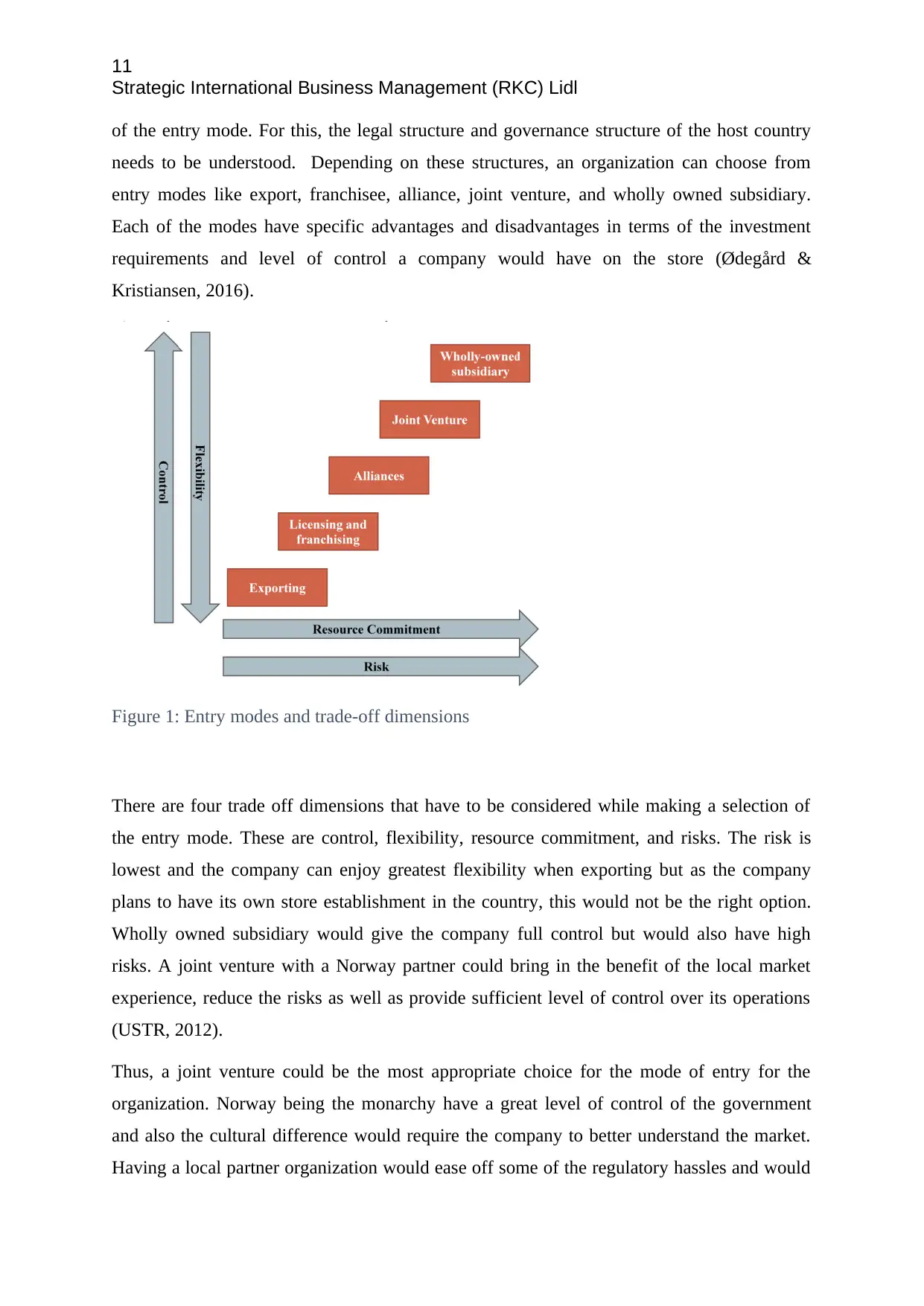
11
Strategic International Business Management (RKC) Lidl
of the entry mode. For this, the legal structure and governance structure of the host country
needs to be understood. Depending on these structures, an organization can choose from
entry modes like export, franchisee, alliance, joint venture, and wholly owned subsidiary.
Each of the modes have specific advantages and disadvantages in terms of the investment
requirements and level of control a company would have on the store (Ødegård &
Kristiansen, 2016).
Figure 1: Entry modes and trade-off dimensions
There are four trade off dimensions that have to be considered while making a selection of
the entry mode. These are control, flexibility, resource commitment, and risks. The risk is
lowest and the company can enjoy greatest flexibility when exporting but as the company
plans to have its own store establishment in the country, this would not be the right option.
Wholly owned subsidiary would give the company full control but would also have high
risks. A joint venture with a Norway partner could bring in the benefit of the local market
experience, reduce the risks as well as provide sufficient level of control over its operations
(USTR, 2012).
Thus, a joint venture could be the most appropriate choice for the mode of entry for the
organization. Norway being the monarchy have a great level of control of the government
and also the cultural difference would require the company to better understand the market.
Having a local partner organization would ease off some of the regulatory hassles and would
Strategic International Business Management (RKC) Lidl
of the entry mode. For this, the legal structure and governance structure of the host country
needs to be understood. Depending on these structures, an organization can choose from
entry modes like export, franchisee, alliance, joint venture, and wholly owned subsidiary.
Each of the modes have specific advantages and disadvantages in terms of the investment
requirements and level of control a company would have on the store (Ødegård &
Kristiansen, 2016).
Figure 1: Entry modes and trade-off dimensions
There are four trade off dimensions that have to be considered while making a selection of
the entry mode. These are control, flexibility, resource commitment, and risks. The risk is
lowest and the company can enjoy greatest flexibility when exporting but as the company
plans to have its own store establishment in the country, this would not be the right option.
Wholly owned subsidiary would give the company full control but would also have high
risks. A joint venture with a Norway partner could bring in the benefit of the local market
experience, reduce the risks as well as provide sufficient level of control over its operations
(USTR, 2012).
Thus, a joint venture could be the most appropriate choice for the mode of entry for the
organization. Norway being the monarchy have a great level of control of the government
and also the cultural difference would require the company to better understand the market.
Having a local partner organization would ease off some of the regulatory hassles and would
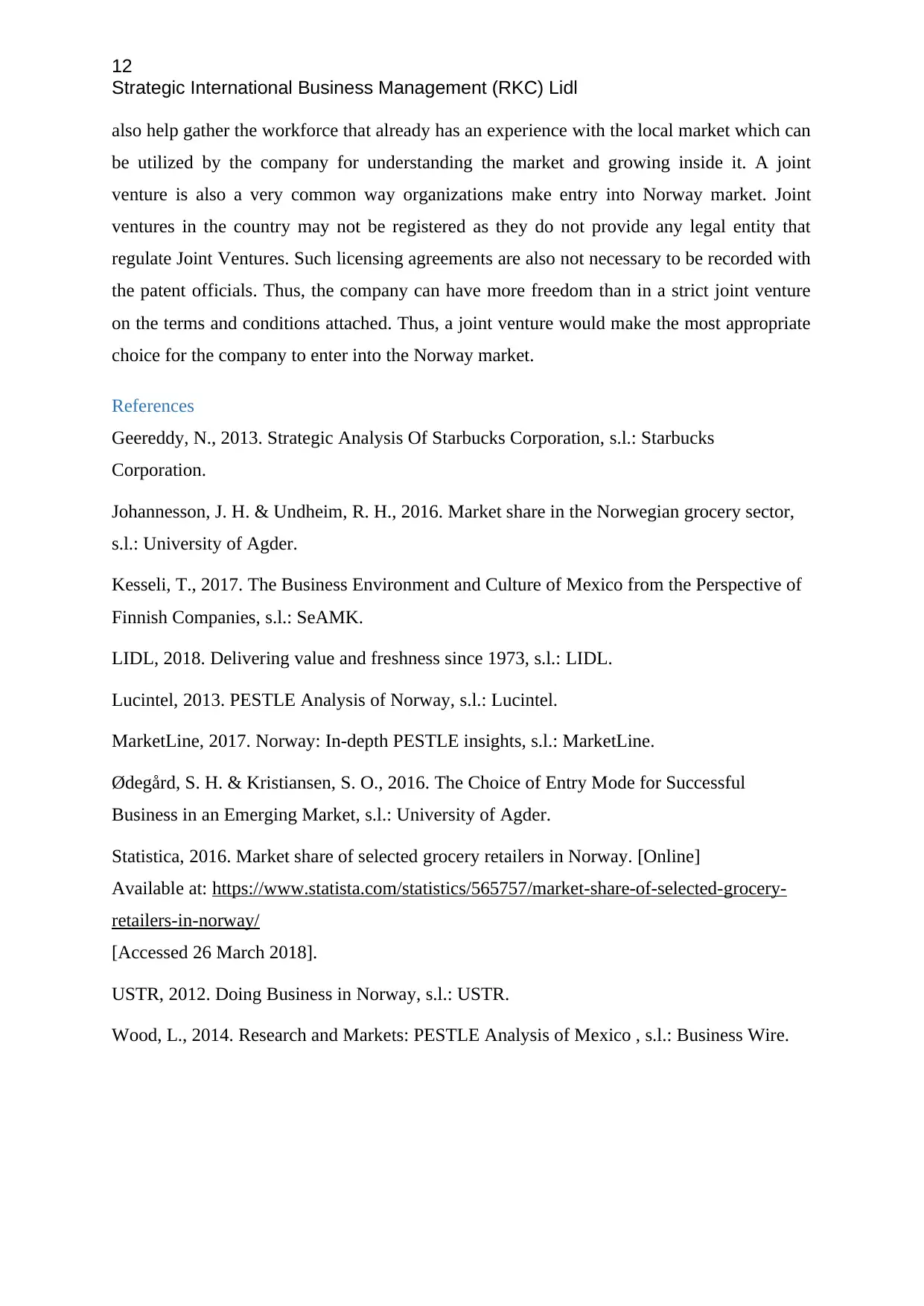
12
Strategic International Business Management (RKC) Lidl
also help gather the workforce that already has an experience with the local market which can
be utilized by the company for understanding the market and growing inside it. A joint
venture is also a very common way organizations make entry into Norway market. Joint
ventures in the country may not be registered as they do not provide any legal entity that
regulate Joint Ventures. Such licensing agreements are also not necessary to be recorded with
the patent officials. Thus, the company can have more freedom than in a strict joint venture
on the terms and conditions attached. Thus, a joint venture would make the most appropriate
choice for the company to enter into the Norway market.
References
Geereddy, N., 2013. Strategic Analysis Of Starbucks Corporation, s.l.: Starbucks
Corporation.
Johannesson, J. H. & Undheim, R. H., 2016. Market share in the Norwegian grocery sector,
s.l.: University of Agder.
Kesseli, T., 2017. The Business Environment and Culture of Mexico from the Perspective of
Finnish Companies, s.l.: SeAMK.
LIDL, 2018. Delivering value and freshness since 1973, s.l.: LIDL.
Lucintel, 2013. PESTLE Analysis of Norway, s.l.: Lucintel.
MarketLine, 2017. Norway: In-depth PESTLE insights, s.l.: MarketLine.
Ødegård, S. H. & Kristiansen, S. O., 2016. The Choice of Entry Mode for Successful
Business in an Emerging Market, s.l.: University of Agder.
Statistica, 2016. Market share of selected grocery retailers in Norway. [Online]
Available at: https://www.statista.com/statistics/565757/market-share-of-selected-grocery-
retailers-in-norway/
[Accessed 26 March 2018].
USTR, 2012. Doing Business in Norway, s.l.: USTR.
Wood, L., 2014. Research and Markets: PESTLE Analysis of Mexico , s.l.: Business Wire.
Strategic International Business Management (RKC) Lidl
also help gather the workforce that already has an experience with the local market which can
be utilized by the company for understanding the market and growing inside it. A joint
venture is also a very common way organizations make entry into Norway market. Joint
ventures in the country may not be registered as they do not provide any legal entity that
regulate Joint Ventures. Such licensing agreements are also not necessary to be recorded with
the patent officials. Thus, the company can have more freedom than in a strict joint venture
on the terms and conditions attached. Thus, a joint venture would make the most appropriate
choice for the company to enter into the Norway market.
References
Geereddy, N., 2013. Strategic Analysis Of Starbucks Corporation, s.l.: Starbucks
Corporation.
Johannesson, J. H. & Undheim, R. H., 2016. Market share in the Norwegian grocery sector,
s.l.: University of Agder.
Kesseli, T., 2017. The Business Environment and Culture of Mexico from the Perspective of
Finnish Companies, s.l.: SeAMK.
LIDL, 2018. Delivering value and freshness since 1973, s.l.: LIDL.
Lucintel, 2013. PESTLE Analysis of Norway, s.l.: Lucintel.
MarketLine, 2017. Norway: In-depth PESTLE insights, s.l.: MarketLine.
Ødegård, S. H. & Kristiansen, S. O., 2016. The Choice of Entry Mode for Successful
Business in an Emerging Market, s.l.: University of Agder.
Statistica, 2016. Market share of selected grocery retailers in Norway. [Online]
Available at: https://www.statista.com/statistics/565757/market-share-of-selected-grocery-
retailers-in-norway/
[Accessed 26 March 2018].
USTR, 2012. Doing Business in Norway, s.l.: USTR.
Wood, L., 2014. Research and Markets: PESTLE Analysis of Mexico , s.l.: Business Wire.
⊘ This is a preview!⊘
Do you want full access?
Subscribe today to unlock all pages.

Trusted by 1+ million students worldwide
1 out of 12
Related Documents
Your All-in-One AI-Powered Toolkit for Academic Success.
+13062052269
info@desklib.com
Available 24*7 on WhatsApp / Email
![[object Object]](/_next/static/media/star-bottom.7253800d.svg)
Unlock your academic potential
Copyright © 2020–2025 A2Z Services. All Rights Reserved. Developed and managed by ZUCOL.





